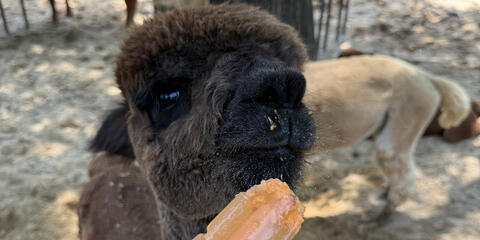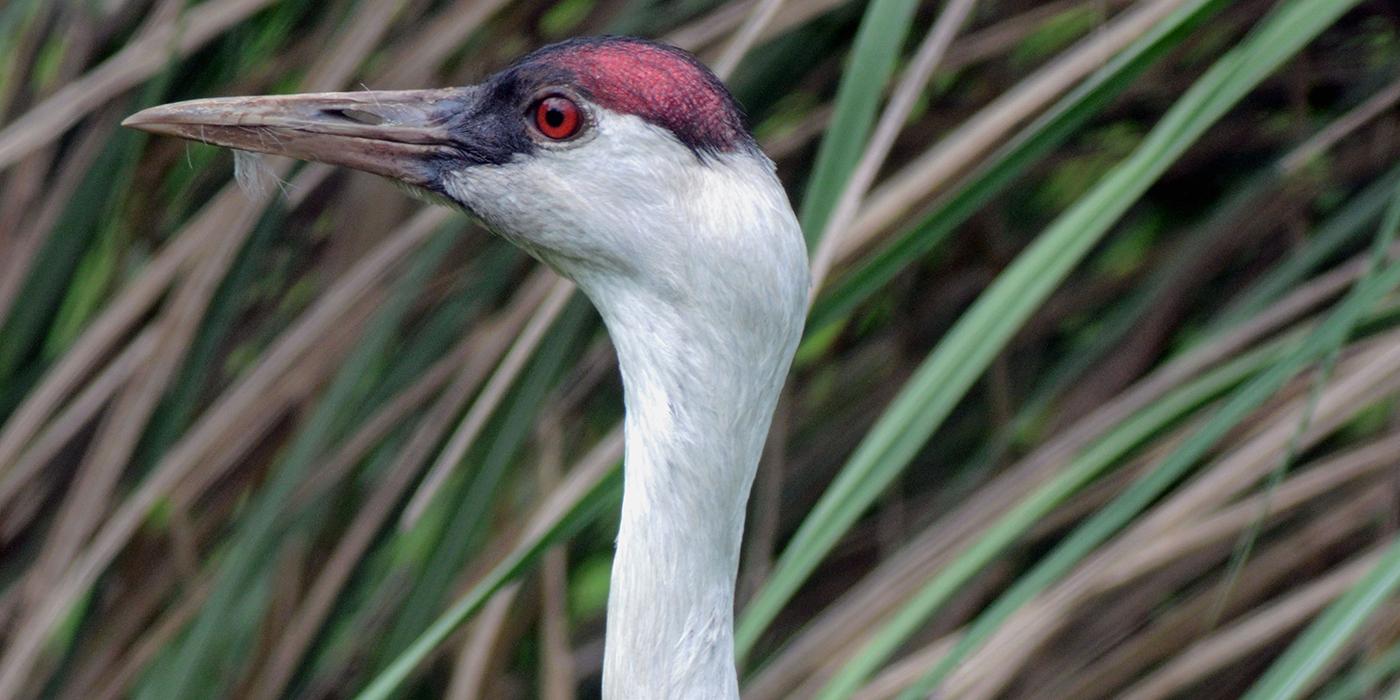Physical Description
The hooded crane is one of the smallest cranes but is still a large bird. Its body is dark gray, often fading to lighter gray-brown on the upper body with gray tips of the feathers. Its primary, secondary and tail feathers are black. The crane's neck is white, extending halfway down the front and nearly to the shoulders in the back. Its head is also white, with the exception of a single patch of bare red skin above the eyes. The hooded crane's iris is hazel-yellow to orange-brown, and its bill is yellow-brown. Its legs and toes are black. Males and females are virtually indistinguishable, although males tend to be slightly larger. Juvenile hooded cranes have crowns covered in black and white feathers during their first year and exhibit some brown-gray wash on their body feathers.
Size
Native Habitat
The hooded crane is found in the boreal forests and grasslands of south-central and south-eastern Siberia, Russia. Breeding is suspected in Mongolia, and two breeding sites have recently been found in the region of Heilongjiang, China. Due to the inaccessibility of the hooded crane habitat, they happen to be one of the least known large birds in the world. Consequently, little is known about their former breeding distribution. The crane's small global population is estimated to be 11,500 individuals that are restricted to fewer than 10 wintering sites in Japan, with smaller numbers wintering in China and South Korea.
Unfortunately, this population is experiencing a continuing decline corresponding to ongoing wetland loss and degradation in their wintering grounds. Another cause for concern is that currently more than 80 percent of the hooded crane population winters in freshwater marshes, wet grassland, coastal tidal flats and farmland on the Japanese Island of Kyushu. It has declined at the majority of these wintering sites. A disease outbreak or similar catastrophic event could potentially wipe out the majority of this crane population. Given the substantial threats to its habitat, it is likely to continue declining in the near future.
Non-breeding cranes are found in shallow open wetlands, natural grasslands and agricultural fields in southern Siberia, northeastern Mongolia, and northern China. Wintering hooded cranes utilize a wide variety of habitats. In China, they tend to roost along the shores of rivers and shallow lakes, and to forage in the muddy edges of lakes and in nearby grasslands, grassy marshes, rice paddies and agricultural fields. In Korea and Japan, they feed almost exclusively at feeding stations and in agricultural fields.
Lifespan
The hooded crane's lifespan in the wild is not well documented, but in human care the median age for both sexes is about 15 years.
Communication
Food/Eating Habits
Hooded Cranes are omnivorous opportunistic feeders. They dig and forage in both their breeding and natural wintering grounds. Their natural diet varies based on the season and their location. It includes aquatic plants, berries, insects, frogs and salamanders in the breeding areas, as well as roots, rhizomes, seeds, blades of grass and small aquatic animals in winter. Cranes in managed populations are fed a diet of crane pellets, smelt, fruits, vegetables, mealworms and crickets.
Reproduction and Development
Male and female hooded cranes mature sexually at about 3 years of age, but frequently take longer to form pair bonds and successfully reproduce. As with other cranes, hooded cranes form lifelong monogamous pair bonds. They will replace a mate that has died. Mated pairs engage in unison calling, which is a complex and extended series of coordinated calls. The birds stand in a specific posture, usually with their heads thrown back and beaks skyward during the display. The male always lifts his wings over his back, while the female keeps her wings folded at her sides. The female will call twice for every one time the male calls.
Hooded Cranes prefer to nest in mossy areas with widely scattered larch trees, avoiding areas that are either too open or too densely forested. Both the males and the females construct a nest made of reeds and grasses in which the female usually lays two eggs in April and early May. One chick often monopolizes the parents' attention, so it is rare for both chicks to survive to fledgling in the wild. The eggs are laid by the female and incubated by both parents for 27 to 30 days. The male defends the nest throughout this time when not incubating. The chicks fledge for 75 days, maturing at three to four years. By Aug., the hooded cranes leave the breeding grounds in family groups.
Conservation Efforts
Seven of the 15 species of cranes are listed as threatened or endangered. The hooded crane is relatively more secure than other cranes of east Asia, due to the absence of intensive human economic activity in their breeding grounds. Moreover, the species (unlike the other East Asian cranes) winters mainly in Japan rather than China and the Korean Peninsula, where threats are greater.
Wild populations have increased from approximately 4,000 birds in the late 1970s to between 9,400 and 9,600 birds listed in a 1996 census. The species does face several critical threats, including drainage of wetlands and intensified logging pressures in Russia's taiga forests, reclamation of wintering grounds in China for agriculture, alterations in the hydrology of these areas and rapid development of key wintering grounds in Korea.
A newly discovered wintering site at Suncheon Bay, South Korea, is threatened by development. The artificially high concentration of birds at some of the wintering grounds, as a result of supplementary feeding, risks a major population reduction from disease or another catastrophe. Other threats in China include pollution of coastal waters, invasive cordgrass in tidal areas, pesticide poisoning, increased levels of human disturbance and overfishing. Some poaching and hunting of breeding birds also occurs.
The Smithsonian Conservation Biology Institute's approach is advantageous because there is adequate, flexible space in often isolated areas away from public activities. The facilities can maintain multiple pairs of cranes and rely on staff with experience and specialized training. SCBI is enhancing reproduction via multiple approaches, including refinement of artificial insemination techniques, semen cryopreservation, hormonal evaluations of pairs and exogenous hormonal induction of breeding.
At SCBI hooded cranes are housed in roofed areas that provide additional protection from predators. Staff at SCBI is also undertaking further husbandry research, including several aviculture techniques, such as use of artificial light to extend seasonal light cycles, artificial insemination, multiple clutching, artificial incubation, puppet rearing and surrogate incubation and parenting. Some of these techniques are being utilized and evaluated in order to breed the species more consistently and to ensure adequate founder representation.
With several other zoos, SCBI participates in the Association of Zoos and Aquariums' Population Management Plan, which includes conservation-oriented research, breeding of selected animals to maintain genetic diversity and cooperative educational efforts.
Help this Species
- Share the story of this animal with others. Simply raising awareness about this species can contribute to its overall protection.
- Try fundraising for conservation organizations in new and fun ways. You could donate your birthday to conservation, host a bakesale to benefit wildlife or Adopt a Species!
- Less is more. Cut down on the demand for resources by consuming less. Buy only what you need, and look for pre-owned or repurposed items before purchasing something brand new.
Animal News

Keeping the Farm Animals Cool with Frozen Treats



